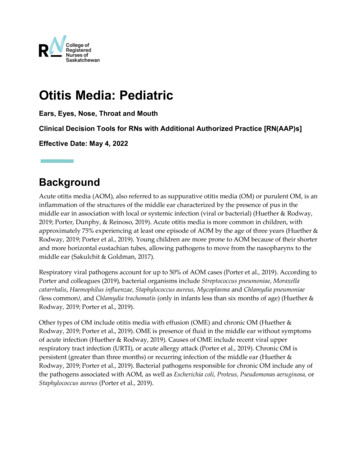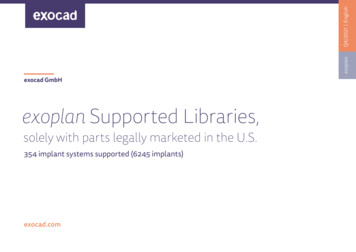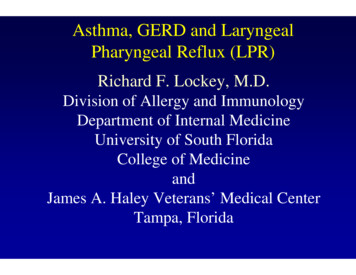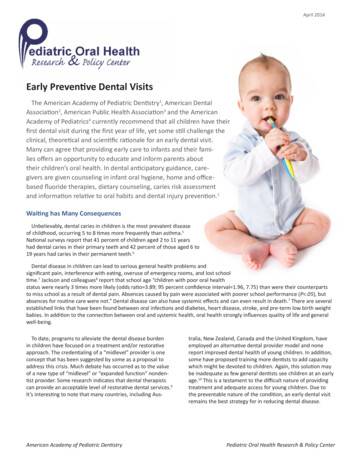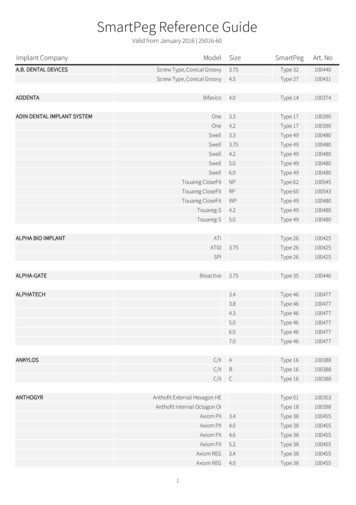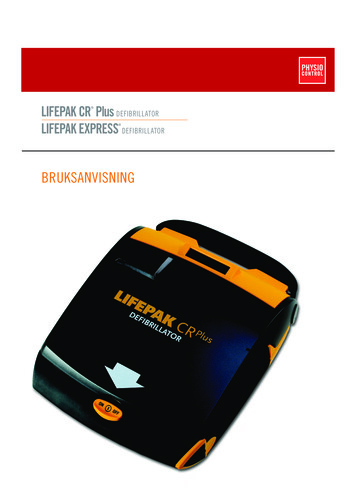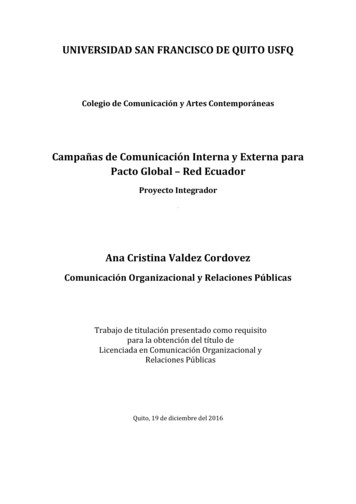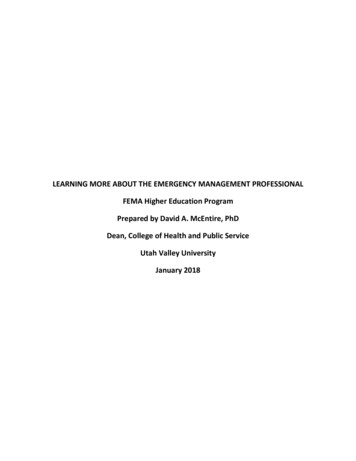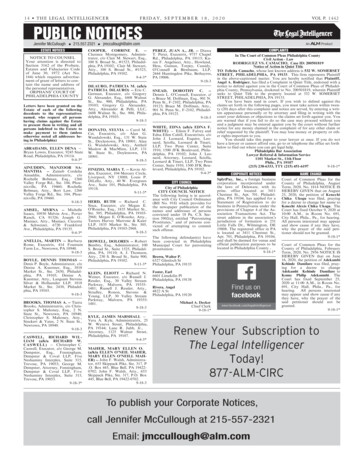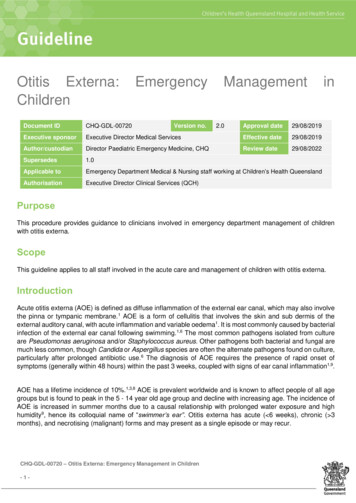
Transcription
Otitis Externa:ChildrenDocument IDCHQ-GDL-00720Executive sponsorEmergencyVersion no.Management2.0Approval date29/08/2019Executive Director Medical ServicesEffective date29/08/2019Author/custodianDirector Paediatric Emergency Medicine, CHQReview date29/08/2022Supersedes1.0Applicable toEmergency Department Medical & Nursing staff working at Children’s Health QueenslandAuthorisationExecutive Director Clinical Services (QCH)inPurposeThis procedure provides guidance to clinicians involved in emergency department management of childrenwith otitis externa.ScopeThis guideline applies to all staff involved in the acute care and management of children with otitis externa.IntroductionAcute otitis externa (AOE) is defined as diffuse inflammation of the external ear canal, which may also involvethe pinna or tympanic membrane.1 AOE is a form of cellulitis that involves the skin and sub dermis of theexternal auditory canal, with acute inflammation and variable oedema1. It is most commonly caused by bacterialinfection of the external ear canal following swimming.1,6 The most common pathogens isolated from cultureare Pseudomonas aeruginosa and/or Staphylococcus aureus. Other pathogens both bacterial and fungal aremuch less common, though Candida or Aspergillus species are often the alternate pathogens found on culture,particularly after prolonged antibiotic use.6 The diagnosis of AOE requires the presence of rapid onset ofsymptoms (generally within 48 hours) within the past 3 weeks, coupled with signs of ear canal inflammation1,9.AOE has a lifetime incidence of 10%.1,3,8 AOE is prevalent worldwide and is known to affect people of all agegroups but is found to peak in the 5 - 14 year old age group and decline with increasing age. The incidence ofAOE is increased in summer months due to a causal relationship with prolonged water exposure and highhumidity9, hence its colloquial name of “swimmer’s ear”. Otitis externa has acute ( 6 weeks), chronic ( 3months), and necrotising (malignant) forms and may present as a single episode or may recur.CHQ-GDL-00720 – Otitis Externa: Emergency Management in Children-1-
The pathophysiology of AOE is attributable to the decreased integrity of the external auditory canal, whoseprotective environment is usually hydrophobic, acidic and containing a protective ceruminous layer. Disruptionof this environment therefore exposes the epithelium of the external canal to water and bacterial infection. 2Infection of the external canal epithelium leads to an acute inflammatory reaction causing erythema andoedema of the canal. Symptomatically this results in otalgia, ottorhea, pruritus and jaw pain. If oedema issevere, hearing loss may result from occlusion of the canal.2A number of factors can contribute and predispose certain individuals to a higher risk of infection.1,2,8,9 Water exposure Localised or generalized eczema Immunocompromised patients Diabetes Mellitus Use of hearing aids, plugs or cotton ear buds Anatomical obstructions (exostoses or canal stenosis) Physiological (decreased ear wax production)AssessmentDiagnosis of AOE requires a rapid onset ( 48hours) of signs or symptoms of external auditory canalinflammation with or without infection. The typical signs and symptoms are: Otalgia (exacerbated by manipulation of ear) Pruritis (more commonly associated with fungal infections) Tenderness of tragus and pinna External canal oedema Erythema Otorrhoea Unilateral ( 90% of AOE cases) Jaw pain Conductive hearing loss Aural fullnessThorough examination of the external ear and ear canal should be undertaken. If otorrhoea is present, swabsshould be taken. The tympanic membrane should be visualised if oedema is not completely occluding theexternal canal, in order to rule out perforation or presence of grommets, which could alter the treatment coursein regards to ototoxic topical drops. The external auditory canal and conchal bowl should be inspected forvesicles that could be indicative of herpes zoster infection or for fungal hyphae.4Care must be taken to distinguish AOE from other potentially more sinister causes of external ear pain withdifferential diagnosis including but not limited to furunculosis, herpes zoster oticus, otomycosis, chronic otitisCHQ-GDL-00720 – Otitis Externa: Emergency Management in Children-2-
externa, malignant (necrotising or skull base osteomyelitis) otitis externa, acute otitis media with perforation,contact dermatitis, squamous cell carcinoma or adenocarcinoma of external auditory canal and retained foreignbody, as these will all have varying treatment.Paramount to physical examination is a targeted history to identify high risk patients who have the potential foralternate diagnosis requiring targeted investigation or imaging and with differing treatment course or potentialdisposition and follow up.ManagementThe management of simple AOE is targeted at both symptomatic control of otalgia and topical antibiotictreatment. Initial antibiotic therapy should be empiric, progressing to specific treatment based on sensitivitiesonce results are obtained from swabs. Analgesia should be promptly initiated and continued in accordancewith a graduated severity analgesic regime; commencing with simple oral analgesia, paracetamol and/oribuprofen, and escalating as necessary for the individual patient’s requirements.Once analgesic requirements have been addressed, examination and history taking for assessment anddefinitive diagnosis should be completed. If possible obtain a microscopy/culture/sensitivity (M/C/S) swab ofotorrhoea or debris within the external auditory canal. If otorrhoea is present, dry aural toilet6 should beperformed to remove debris and discharge. Dry aural toilet involves dry mopping the ear with rolled tissuespears or similar every six hours until the external canal is dry. If nothing on examination or history is indicativeof the need to modify treatment or investigation and simple AOE is the working diagnosis, the following stepsshould be performed for definitive management.2,5,6,91. Dry aural toilet (syringing ear should be STRICTLY avoided).2. Administer combination corticosteroid and antibiotic ear drops.Topical corticosteroid and antimicrobial dosing for children acute otitis externaNoperforationDexamethasone 0.05% framycetin 0.5%Three drops instilled into the affected ear, threetimes daily for seven days. gramicidin 0.005% ear drops(SOFRADEX )PerforationCiprofloxacin 0.3% ear drops(CILOXAN )Five drops instilled into affected ear two times dailyfor seven days.3. If suspected pseudomonas otitis externa with either significant canal wall oedema or associated withmyringitis, infected grommets with granulations, or infected cholesteatoma with polyp/granulationsTopical corticosteroid and antimicrobial dosing for children with complicated acute otitis externaComplicatedCiprofloxacin 0.3% Hydrocortisone 1% ear drops(CIPROXIN HC )Three drops instilled into the affected ear, twicedaily until symptoms have cleared for 2 days.Duration not exceeding 2 weeks.ALERT:Ciproxin HC is not on the PBS or LAM. If used for the indications listed in this CHQMAC endorsedguideline, Individual Patient Approval is not required. All other use will require individual patient approvalsigned off by IDCHQ-GDL-00720 – Otitis Externa: Emergency Management in Children-3-
4. If fungal infection is suspected:Topical antifungal dosing for children with suspected fungal acute otitis externaFungalTriamcinolone acetonide 0.1% neomycin sulfate 0.25% gramicidin 0.025% nystatin 100,000 units/mL ear drops(KENACOMB/OTOCOMB )Three drops instilled into the affected ear, threetimes daily for 7 days.5. Insertion of a wick to facilitate administration of drops is recommended in situations of significant canaloedema. A wick allows drops to bypass oedema and enables administration to the infected area. Inserta dry wick into the external ear canal, then administer drops as per above.6. Review 48-72 hours after initiation of treatment by primary care physician to check clinical progressand review culture results is recommended.7. Referral to ENT outpatient clinic is indicated for uncontrolled or severe pain and/or failure of resolutionwithin a reasonable time frame, for example two weeks.An important component of the treatment of AOE is maintaining strict water precautions for 10-14 days. Thisinvolves refraining from water sports and taking precautions during bathing.It is also advised not to use headphones during the recovery period.ALERT: System AntibioticsSystemic antimicrobials should not be prescribed as initial therapy for diffuse,uncomplicated AOE unless there is extension outside the ear canal or the presence ofspecific host factors that would indicate a need for systemic therapy.This should then be discussed with ENT Registrar prior to prescription.ALERT: PreparationsNon-ototoxic preparation should be prescribed when the patient has a known orsuspected perforation of the tympanic membrane, including a tympanostomy tube(grommet). CIPROFLOXACIN is the drug of choice.ALERTFrequent use of topical ciprofloxacin increases the likelihood of local bacterialresistance particularly in pseudomonas.ComplicationsMalignant (necrotising or skull base osteomyelitis) otitis externa is a serious and potentially fatal complicationof AOE. This complication affects immunocompromised individuals such as those with chemotherapy-inducedaplasia, refractory anaemia, chronic leukaemia, lymphoma, splenectomy, neoplasia and renal transplantation2.Pathophysiology in this case reflects spread of the infection through the floor of the external auditory canal tothe base of the skull, with associated formation of granulation tissue. P. aeruginosa is the most common causeCHQ-GDL-00720 – Otitis Externa: Emergency Management in Children-4-
however fungal pathogens can also cause the condition especially in patients with AIDS, in whom Aspergillusfumigatus is the most common pathogen. These patients have typically failed appropriate topical and/orsystemic antibiotic therapy. On examination the external auditory canal may show presence of granulationtissue or a polyp on the floor of the canal, as well as exposed bone. Extension into the skull base may resultin cranial neuropathies, with the facial nerve most commonly involved. Carcinoma of the ear canal has a similarappearance and biopsy is necessary to rule out malignancy.2 All suspected cases of malignant otitis externashould be discussed with ENT in a timely manner.DispositionDue to the generally uncomplicated nature of AOE, disposition of patients is usually discharge from hospitalwith close follow up arranged either with a primary care physician at the 48-72h mark or in ENT outpatientclinic (especially if ear toilet is required). Advice should be given about the prevention of recurrence –particularly ensuring ears are dry post water sports and consideration of the use of ear plugs. If analgesicrequirements are significant then consultation with ENT registrar for review or admission to hospital may berequired. If systemic illness is present then a consult with ENT Registrar on call would be appropriate. If thereis a concern for any of the alternative diagnosis other than uncomplicated AOE then ENT consult should besought in a timely manner.ConsultationKey stakeholders who reviewed this version: Paediatric Emergency SMO, QCH Paediatric Emergency SMO, QCH Director, Paediatric Otolaryngology Head and Neck Surgery, QCH Director, Infectious Diseases, QCH Critical Care Pharmacist, QCHDefinition of termsTermDefinitionAOEAcute Otitis ExternaENTEar, Nose and ThroatReferences and suggested reading1.Rosenfeld RM, Schwartz SR, Cannon CR, et al. American Academy of Otolaryngology-Head and NeckSurgery Foundation. Clinical practice guideline: acute otitis externa. Otolaryngol Head Neck Surg.2014;150(suppl 1):S1-S24.2.Dr Nirmal Patel and Dr Nicholas Leith. Treating acute otitis externa. Australian Doctor, vol 21 March,2013CHQ-GDL-00720 – Otitis Externa: Emergency Management in Children-5-
3.Rosenfeld RM, Brown L, Cannon CR, Dolor RJ, Ganiats TG, Hannley M, et al. Clinical practice guideline:Acute otitis externa. Otolaryngol Head Neck Surg 2006;134(4 Suppl):S4-23. [PubMed]4.Rosenfeld RM, Singer M, Wasserman JM, Stinnett SS. Systematic review of topical antimicrobial therapyfor acute otitis externa. Otolaryngol Head Neck Surg 2006;134(4 Suppl):S24-48. [Pubmed]5.Wall GM, Stroman DW, Roland PS, Dohar J. Ciprofloxacin 0.3%/dexamethasone 0.1% sterile oticsuspension for the topical treatment of ear infections: a review of the literature. Pediatr Infect Dis J2009;28(2):141-4. [PubMed]6.Otitis Externa [revised March 2015]. In: eTG complete [Internet] March 2015. Melbourne: TherapeuticGuidelines Limited; 2015 March7.Van Asperen I, De Rover C, Schijven J, et al. Risk of otitis externa after swimming in recreational freshwater lakes containing Pseudomonas aeruginosa. BMJ 1995; 311:1407-10. BMJ Clin Evid. 2010 Aug3;2010. pii: 0510.8.Hajioff D and Mackeith S. Otitis Externa, Clin Evid (Online) 2010 pii: 0510. [PMC free article] [PubMed]McWilliams C, Smith C and Goldman R, Acute Otitis Externa in Children, Canadian Family Physician.2012 Nov; 58(11): 1222–1224.Guideline revision and approval historyVersion No.Modified byAmendments authorised byApproved by1.014/06/2016Director PaediatricEmergency DepartmentMedicines AdvisoryCommitteeExecutive Director MedicalServices2.029/08/2019Director PaediatricEmergency DepartmentDivisional Director Critical Executive Director ClinicalCareServices (QCH)KeywordsOtitis externa, acute otitis externa, 00720AccreditationreferencesNSQHS Standards (1-8): Medication Safety Standard 4CHQ-GDL-00720 – Otitis Externa: Emergency Management in Children-6-
AOE has a lifetime incidence of 10%.1,3,8 AOE is prevalent worldwide and is known to affect people of all age groups but is found to peak in the 5 - 14 year old age group and decline with increasing age. . If otorrhoea is present, dry aural toilet6 should be performed to remove debris and discharge. Dry aural toilet involves dry mopping the .
